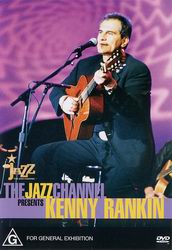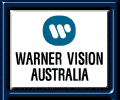Kenny Rankin-The Jazz Channel Presents (2001) |
|
Kenny Rankin-The Jazz Channel Presents (2001) |
|


|
| BUY IT |
| General | Extras | ||
| Category | Music | Featurette-Meet The Artist | |
| Rating |

|
||
| Year Of Production | 2001 | ||
| Running Time | 74:12 | ||
| RSDL / Flipper | No/No | Cast & Crew | |
| Start Up | Menu | ||
| Region Coding | 2,4 | Directed By | Waymer Johnson |
|
Studio
Distributor |
 Warner Vision |
Starring | Kenny Rankin |
| Case | Soft Brackley-Transp | ||
| RPI | $39.95 | Music | Kenny Rankin |
| Video | Audio | ||
| Pan & Scan/Full Frame | Full Frame |
English Dolby Digital 5.1 (448Kb/s) English Dolby Digital 2.0 (224Kb/s) English dts 5.1 (1536Kb/s) |
|
| Widescreen Aspect Ratio | None | ||
| 16x9 Enhancement | No | ||
| Video Format | 576i (PAL) | ||
| Original Aspect Ratio | 1.33:1 | Miscellaneous | |
| Jacket Pictures | No | ||
| Subtitles | None | Smoking | No |
| Annoying Product Placement | No | ||
| Action In or After Credits | Yes, end titles over last song | ||
The Jazz Channel Presents: Kenny Rankin is another in a series of TV specials featuring concerts by black musicians produced by BET on Jazz. Except for one thing: Kenny Rankin is not black. In fact, none of the other musicians on stage are black either, and the audience seems predominantly white. So much for "BET" standing for "Black Entertainment Television." Which is just as well, because I think jazz has a strong cross-cultural appeal and there are very good jazz musicians from all sorts of backgrounds (including some really good ones in Japan that I've heard).
As a young man growing up in New York, Kenny was influenced by many musicians, including jazz and Latin artists. He taught himself to play the guitar, and performed many times on The Tonight Show with Johnny Carson. He has released many albums, and well as written songs for other people, including Peggy Lee, Carmen McCrae and Mel Torme. Even when he sings other people's songs (such as the Beatles' Blackbird) he imposes his own unique style onto them and makes them sound like his own.
Kenny plays the guitar and sings a combination of jazz/pop standards alongside other smooth and easy listening jazz numbers in this concert. Backed by a four piece band (Bill O'Connell on the piano, David Finck on acoustic bass, Kim Plainfield on drums and Joe Beck on acoustic and electric guitar) and a string quartet, the audience is quiet but appreciative.
The opening number is an oldie but goodie: a Cole Porter song called You'd Be So Nice To Come Home To, featuring Kenny on vocals accompanied by the jazz band. Then Kenny picks up the acoustic guitar for the next three songs, which includes the Thelonious Monk classic Round Midnight. Then comes the Gershwin song Love Is Here To Stay. Two smooth jazz numbers follow.
As mentioned earlier, Kenny's rendition of Blackbird is quite unique and a real pleasure to listen to - it's a bit of a solo effort as Kenny sings accompanied only by his own guitar. Birembau sounds Latin, and the next two tracks are fairly quiet and reflective. Kenny obviously really enjoyed singing Soft Guitar. He gives the guitar a bit of rest in Blame It On My Youth, but picks it up again in Peaceful. I quite like the last two tracks: Haven't We Met and While My Guitar Gently Weeps.
The string quartet joins Kenny on four songs: When Sunny Gets Blue, Misty Roses, Peaceful and the last song While My Guitar Gently Weeps. This seems like a bit of waste as the players were sitting on stage probably bored out of their minds most of the time.
| 1. You'd Be So Nice To Come Home To 2. Why Do Fools Fall In Love 3. When Sunny Gets Blue 4. Round Midnight 5. Love Is Here To Stay 6. Sunday Kind Of Love 7. Misty Roses 8. Blackbird | 9. Birembau 10. More Than You Know 11. She's A Lady/In The Name Of Love 12. Soft Guitar 13. Blame It On My Youth 14. Peaceful 15. Haven't We Met 16. While My Guitar Gently Weeps |
This is a full frame transfer (1.33:1, not 16x9 enhanced). Earlier titles in the Jazz Channel Presents ... series tended to plagued by aliasing and shimmering artefacts (from NTSC to PAL conversion, perhaps?) and occasionally low level video noise. I'm happy to report that this transfer comes across very well with almost no real artefacts to speak of.
Concerts and other low light situations are notoriously difficult to capture on film or video, and I suspect this one has been captured on digital video. Detail levels are fairly high, but probably falling just a tad short of reference quality as the transfer looks just a little bit too soft to my eyes. Colour saturation and black levels are pretty good (and consistent with the results one would expect using digital video). There's no low level video noise or objectionable artefacts to speak of.
There are no subtitle tracks on this single sided single layered disc.
| Sharpness | |
| Shadow Detail | |
| Colour | |
| Grain/Pixelization | |
| Film-To-Video Artefacts | |
| Film Artefacts | |
| Overall |
There are three audio tracks on this disc: Dolby Digital 5.1 (448 Kb/s), Dolby Digital 2.0 (224 Kb/s), and dts 5.1 (1536 Kb/s). I mainly listened to the dts track, which sounds really really good and pleasant to listen to.
This sounds like a native 5.1 mix, with the sound of the audience spread across the rear channels and the music spread across the front channels. The fidelity of the audio track was so good that I could distinguish the sounds of individual claps. The subwoofer is lightly used to support the music and is never intrusive.
The Dolby Digital 5.1 track in comparison sounds slightly harsher than the dts track but still quite full-bodied. In fact, it sounds fuller than the dts track. The Dolby Digital 2.0 track, in contrast to many other 2.0 music tracks I've listened to, doesn't sound too bad and for once has not been mastered at a much lower level in comparison to the surround tracks.
| Dialogue | |
| Audio Sync | |
| Clicks/Pops/Dropouts | |
| Surround Channel Use | |
| Subwoofer | |
| Overall |
Consistent with other titles in the series, the extras are limited to a "Meet The Artist" featurette. Surprisingly, we don't get a discography or biography.
The menus are full frame and static and consistent with other titles in the series.
This is your standard interview interspersed with concert excerpts. In contrast with earlier titles in this series, the interview is not constrained to a small window on the screen but is presented full screen (about time!). Kenny talks about his life and career, and towards the end hints more than once about recovering from "substance abuse". Inquiring minds want to know! Just what did you take, Kenny? :-)
NOTE: To view non-R4 releases, your equipment needs to be multi-zone compatible and usually also NTSC compatible.
I suspect this title is identically featured across all regions.
The Jazz Channel Presents Kenny Rankin will appeal to those who like a mellow, but playful, voice singing smooth jazz. It features a more than acceptable video transfer, and excellent audio tracks. The extras are limited to a featurette.
| Video | |
| Audio | |
| Extras | |
| Plot | |
| Overall |
| Review Equipment | |
| DVD | Pioneer DV-626D, using Component output |
| Display | Sony VPL-VW10HT LCD Projector, ScreenTechnics 16x9 matte white screen (254cm). Calibrated with Video Essentials/Ultimate DVD Platinum. This display device is 16x9 capable. |
| Audio Decoder | Built in to amplifier/receiver. Calibrated with Video Essentials/Ultimate DVD Platinum. |
| Amplification | Denon AVR-3300 |
| Speakers | Front and rears: B&W CDM7NT; centre: B&W CDMCNT; subwoofer: B&W ASW2500 |